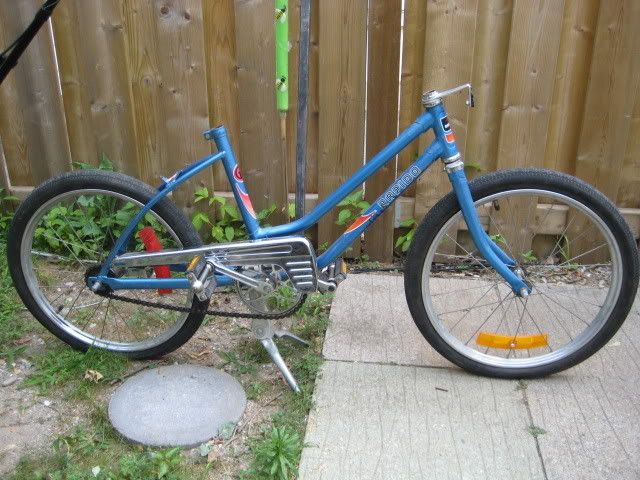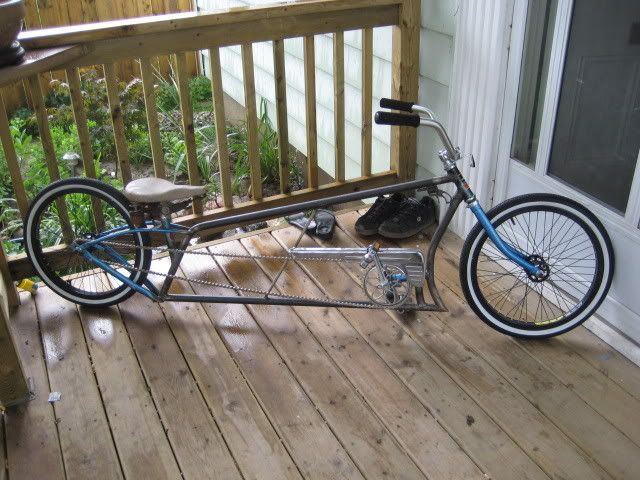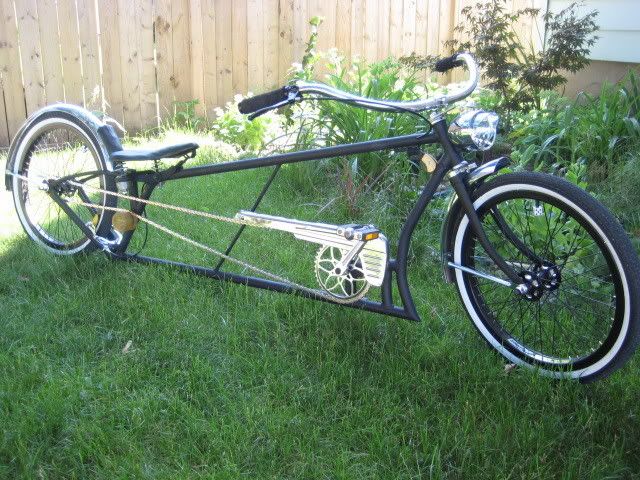You are using an out of date browser. It may not display this or other websites correctly.
You should upgrade or use an alternative browser.
You should upgrade or use an alternative browser.
which tube size to build a bike?
- Thread starter jdpcsm
- Start date

Help Support Rat Rod Bikes Bicycle Forum:
This site may earn a commission from merchant affiliate
links, including eBay, Amazon, and others.
Without a question,, No doubt about it.. the best size to use is the size you happen to have.. or can get cheap... If you have to buy something EMT conduit is not bad choice. Really there is no good answer to this question. It really depends on what your doing. I like fat downtubes... 1 1/2, 1 5/8, 1 3/4.... And I like fat rearsets as well...
dry sand and fire(aka oxy/acetylene and a rose bud tip) and something solid to bend it on...
put dry sand in the tube weld caps over both ends...heat to cherry red and then bend over whatever has the right radius for what you want....be warned itll stay hot forever and wear gloves :wink:
as for tube size i like 3/4" and 1" for the frame 5/16" for the rear stays
put dry sand in the tube weld caps over both ends...heat to cherry red and then bend over whatever has the right radius for what you want....be warned itll stay hot forever and wear gloves :wink:
as for tube size i like 3/4" and 1" for the frame 5/16" for the rear stays
You can buy pipe benders that use a hydraulic jack.
I think soldering would be too weak for that application. Brazing for bicycle frames assumes you have the proper lugs to braze into. That leaves welding for pipe-type frames.
I think soldering would be too weak for that application. Brazing for bicycle frames assumes you have the proper lugs to braze into. That leaves welding for pipe-type frames.
I say 'ugh" to conduit. It is a very cheap grade of steel and the 1" OD size bends way too easy. I use 1" 1020 steel if I am using new tubing but to be honest I mostly just cut up damaged Schwinn frames, really just any bike frame. I can fillet-braze (oxy-acetylene), but most of the time I have a friend of mine do my welding. The machine he's using is wire-feed using flux-core wire, which is a little sloppy. It would be better with an Argon gas shield but it's his machine.
Conduit is fine for routing electrical wires but is a very poor choice for the stresses of a bicycle frame. The fumes that come of it are deadly too. I have seen conduit bicycle frames that have failed.
I think the 1020 mild tubing with a 1/16 wall is great. 1 inch to 1-1/2 - O.D. it's all good, and it's up to the job.
Dorian
I think the 1020 mild tubing with a 1/16 wall is great. 1 inch to 1-1/2 - O.D. it's all good, and it's up to the job.
Dorian
I like conduit, it's light and it's CHEAP! The fumes are toxic, that's why you sand (grind) the welding areas before welding, also weld in a well ventilated area. I've stated in other posts, do not use LONG unsupported spans of conduit. If you design your frame with the proper supports you should not have a problem. I weigh 250lbs. and have not had any problems with frame failure. As far as bending. I use a conduit bender, It takes a bit of "practice". But if you screw up, it's cheap enough to throw away! Click on MY/INTRO to see a couple of bikes made with conduit. ....Dorian IS correct, 1020 mild tubing IS a better choice. BUT, the bottom line is, use whatever is best for you.................Below is a pic of to long a "span" for conduit! :shock:

Not to long a span (about $6 to make this frame)


Not to long a span (about $6 to make this frame)

I wouldn't like to dwell on the topic of 1020 VS conduit too long, but :shock: . I think the term that best describes conduit use in bicycle applications is "substandard". There are reasons that most people don't use it for making bicycles, "one"- because it is extremely toxic when welded, and "two"- it is generally recognized as the poorest choice of building material for this type of application. Cheap it is, but like anything you get what you pay for. There is the best way and the cheapest way, and in this case the cheapest way is the substandard way.
Under ideal conditions someone could possibly make a bicycle with conduit that might hold up, and not poison the builder :?: , but to recommend conduit as a general purpose building material is not a good idea. It is the poorest unsafest choice.
Best to work towards the best you can do - with the highest grade of building materials you can afford. When it comes to building materials- less is not more. I have strong feelings on this subject as I have seen conduit bike frames break .
.
Don't get me wrong, I'm only against conduit, not people
Dorian
Under ideal conditions someone could possibly make a bicycle with conduit that might hold up, and not poison the builder :?: , but to recommend conduit as a general purpose building material is not a good idea. It is the poorest unsafest choice.
Best to work towards the best you can do - with the highest grade of building materials you can afford. When it comes to building materials- less is not more. I have strong feelings on this subject as I have seen conduit bike frames break
Don't get me wrong, I'm only against conduit, not people
Dorian
Some of you may remember the "Conduit King" Marty Eden. Pretty talented guy. Wish I had pictures of all his conduit built bikes. Here you'll see some...Dorian said:Under ideal conditions someone could possibly make a bicycle with conduit that might hold up, and not poison the builder :?:
http://bikerodnkustom3.homestead.com/MartyEden.html
http://bikerodnkustom3.homestead.com/MauiMarty6_02.html
http://bikerodnkustom3.homestead.com/marty7_01.html
Marty Eden of Hawaii was a good designer, but his bikes basically never got used for anything except model shots at the beach. He was also not afraid to say that his bikes were made from crappy material. He did make one decent quality bike when he went to California and made one at the old "American Legend" bike factory, but it was not made out of conduit. While Marty's conduit bikes looked good, they were not made under ideal conditions, and some of them did not hold up. Joint breaks did happen on his bikes. If Marty Eden had made his bikes out of mild steel tube he really would have made a name for himself.
Marty Eden had some great designs, but his bikes were hardly more than quickly made full size mock ups of his drawings. Bikes that looked good in pictures, but little more. This is possibly why you almost never saw any riding shots of his bikes. I wish Marty Eden well .
.
Dorian
Marty Eden had some great designs, but his bikes were hardly more than quickly made full size mock ups of his drawings. Bikes that looked good in pictures, but little more. This is possibly why you almost never saw any riding shots of his bikes. I wish Marty Eden well
Dorian
There's just no reason to use conduit, except for convenience. There are steel supply places with no minimum order, and lots of them will have a bin of discount offcuts, perfect for bike building and cheap.
Well Dorian . I messed with some conduit at first. I found ridgid conduit is some strong stuff. The fumes come from welding galvanize . It happens with any of it. I switched to schedule 40 pipe. Makes alot heavier bike ,but its bullet proof. I would much rather ride a bike that was welded right using ridged conduit than one stuck together with a bunch of boogers out of scedule 40 pipe. The level of welding skill has more to do with strong welds than choice of materials.
Uncle Stretch said:Well Dorian . I messed with some conduit at first. I found ridgid conduit is some strong stuff. The fumes come from welding galvanize . It happens with any of it. I switched to schedule 40 pipe. Makes alot heavier bike ,but its bullet proof. I would much rather ride a bike that was welded right using ridged conduit than one stuck together with a bunch of boogers out of scedule 40 pipe. The level of welding skill has more to do with strong welds than choice of materials.
A good weld is always the way to go. Chrome moly is also a tricky metal to weld properly. But its a real problem when some people recommend conduit as a great all around material to work with :shock: , without telling the whole story of its toxicity and metalurgical qualities, especially to young first time builders who don't know that they need to protect themselves. Conduit was designed for a very specific purpose, and that purpose wasnt to build bikes with.
Better to build a battleship out of schedule 40 pipe any day than to use conduit, less chance of breakage any way you look at it. Go 1020 if you can afford it, it costs just a little bit more
Dorian
---------------------------
--------------------
--------
Hey I wanted big smiles on my choice too!!!!! :roll:
I was thinking of using some 1" conduit in my current bike build, but I think this thread has changed my mind. I already the conduit bent into the shape I want. I used used the "Y" of a large tree in my front yard and got some long smooth curves. Hmmm... if I was able to bend it that easily by hand, maybe I shouldn't be using for a bike frame. :shock: If I bought some 1020 or schedule 40, how could I get the same bends? Would a 1" conduit bender work? I think I read on the old chopperbicycle.net forums that you might could take your tubing to a muffler shop and for a small cash donation ( :lol: ) they would bend it for you.
Latest posts
-
-
-
-
-
TRADITIONAL ⚡️⚡️⚡️THUNDERBOLT⚡️⚡️⚡️”AWESOME” HELP⚡️⚡️⚡️PART FOUND⚡️⚡️⚡️Beehive Springer
- Latest: Shrunken_Head_Pedaler
-
-






